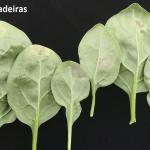Spinach Downy Mildew
Spinach downy mildew, caused by Peronospora farinosa f.sp. spinaciae, has been appearing sporadically in the northeast since 2014. The increase in incidence of this disease has coincided with the growing popularity of high tunnels. As with most downy mildews, cool (59-70°F), humid conditions are ideal for this pathogen.
Signs and symptoms: Spinach downy mildew often begins as irregular yellow patches on upper leaf surfaces. Purplish-gray sporulation will be observed on the undersides of leaves. Occasionally, sporulation may be seen on upper leaf surfaces as well. Lesions may eventually dry out and turn brown. Sporangia are produced in the morning and dispersed by wind currents over the course of the day. Infection can be latent for quite some time until conditions are favorable for disease development. Signs and symptoms sometimes appear post-harvest.
Management: Sixteen races of P. farinosa have been identified to date, with races 12 and 14 most recently detected in the northeast. Several resistant cultivars of spinach are available; however, no cultivar is resistant to all races of the pathogen. It is best to grow an assortment of resistant cultivars. See http://vegetablemdonline.ppath.cornell.edu/NewsArticles/Spinach%20Varieties-DM%20Occurrence-Northeast.pdf for a listing of resistant cultivars.
Apply row covers when leaves are dry. Increase air circulation and reduce humidity in high tunnels. Use drip irrigation if possible. Rotate out of spinach for at least 3 years. P. farinosa is capable of producing oospores, thick-walled structures which are capable of survival in soil; however, two mating types of the pathogen have to meet in order for oospores to be formed, and the frequency with which this occurs is unknown. Destroy all infected crops and crop residues. Allow a fallow period of at least two weeks between winter and spring high tunnel crops.
Fungicides cannot cure spinach downy mildew, but preventive applications can curb the spread of the pathogen. Several conventional and OMRI-listed fungicides are labeled for control of spinach downy mildew. See the New England Vegetable Management Guide for a full listing: http://nevegetable.org/.
The Center for Agriculture, Food and the Environment and UMass Extension are equal opportunity providers and employers, United States Department of Agriculture cooperating. Contact your local Extension office for information on disability accommodations. Contact the State Center Director’s Office if you have concerns related to discrimination, 413-545-4800 or see ag.umass.edu/civil-rights-information.


